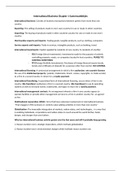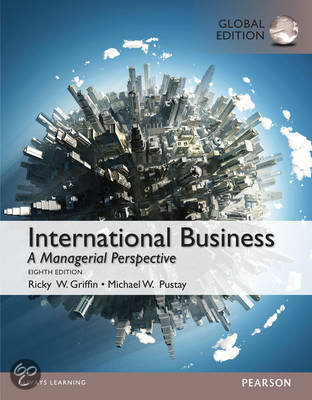International Business Chapter 1 Samenvattinkjes
International business: Consists of business transactions between parties from more than one
country.
Exporting: The selling of products made in one’s own country for use or resale in other countries.
Importing: The buying of products made in other countries country for use or resale in one own’s
country.
Merchandise exports and imports: Trading goods, tangible products, such as clothing, computers.
Service exports and imports: Trade in services, intangible products, such as banking, travel.
International investments: Capital supplied by residents of one country to residents of another.
- FDI( Foreign Direct Investments): Investments made for the purpose of actively
controlling property, assets, or companies located in host countries. PURELY TO
CONTROL SOMETHING
- FPI (Foreign Portfolio investments): Purchases of foreign financial assets (stocks,
bonds and certificates of deposit) for a purpose other than control. NO CONTROL
International licensing: A contractual arrangement in which a firm authorizes one countrie licenses
the use of its intellectual property ( patents, trademarks, brand , names, copyrights, or trade secrets)
to a firm in a second country in return for a royalty payment.
International franchising: A specialized form of international licensing, occurs when a firm in one
country (the franchisor) authorizes a firm in a second country (the franchisee) to use its operating
systems as well as its brand names, trademarks, and logos in return for a royalty payment.
International management contract: An arrangement wherein a firm in one country agrees to
operate facilities or provide other management services to a firm in another country for an agreed-
on fee.
Multinational corporation (MNC): Firms that have extensive involvement in international business.
‘’That engages in FID na downs or controls value-adding activities in more than one country’’
Globalization: The inexorable intergration of markets, nation-states, and technologies… in a way that
is enabling individuals, corporations and nation-states to reach around the world farther, faster,
deeper, and cheaper than ever before.
Why has international business activity grown over the few years and will it probably keep growing
1. Reason number one is strategic imperatives, which motivate globalization
2. Reason number two is environmental changes which facilitate reason number one
, Strategic imperatives; A business goal, objective or target that has
the highest priority
1. To leverage core competencies; A distinctive strengt or advantage that is central to a firm’s
operation. Een sterk punt dat je hebt in je thuismarkt dat je wilt uitbreiden in andere landen om zo
opbrengsten en winst te verhogen.
2. TO acquire resources and supplies; To acquire resources such as materials, labor, capital or
technology, some organizations must go to foreign sources because certain raw materials are either
scarce or unabailable locally.
3. TO seek new markets; When domestic markets mature, it becomes increasingly difficult to
generatie high revenu and profit growth, Companies cannot expect to achieve significant growth in
sales from their products in these markets and have aggressively moved into emerging markets.
4. TO better compete with rivals; If Coca-Cola expands aggressively around the world, Pepsi has little
choice but to follow and try to keep up. Should Pepsi allow Coca-Cola to dominate important markets,
Coca-Cola could use profts from those markets to finance attacks on Pepsi in still other markets.
The Environmental causes of Globalization
1. Changes in the political environment
-Reduction of trade and investment barriers
– The collapse of European Communism
– The ideological and policy changes undertaken by China and India
2. Technological changes:
– Advances in Transportation
– Improvements in Information Processing
– Changes in Communications Technology
DESTEPA DESTEP Analysis clarifies how a company can best deal with such Macro-
economic factors and how to adjust their strategy accordingly.
• Demografic • Political-juridistic
• Economic • Ecologic
• Social-Cultural • Technological
Emerging markets:
Upcoming markets, who’s growth or expectations of the future, exceeds the growth of traditional
markets.
- BRIC landen; Brazilë, Rusland, India, China
- Big ten: South korea, South africa, Argentinië, Indonesië , India, Turkije, Poland,
Brazilië, China, Mexico.






